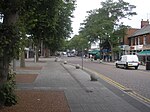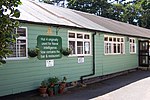Bletchley Flyover
1959 establishments in EnglandBletchleyBridges completed in 1959Buildings and structures in Milton KeynesConcrete bridges in England ... and 4 more
East West RailRail transport in Milton KeynesRailway bridges in BuckinghamshireUse British English from July 2020

The Bletchley Flyover is railway viaduct that crosses the West Coast Main Line (WCML) just south of Bletchley railway station in Milton Keynes, England. It was originally a reinforced concrete railway viaduct that carried the former Varsity line between Oxford and Cambridge from 1959 until its closure in 1968. The flyover was retained, but largely unused until 2021, when the East West Rail Alliance demolished then rebuilt the structure. It reopened for engineering use in early 2022.
Excerpt from the Wikipedia article Bletchley Flyover (License: CC BY-SA 3.0, Authors, Images).Bletchley Flyover
Buckingham Road, Milton Keynes Old Bletchley
Geographical coordinates (GPS) Address Nearby Places Show on map
Geographical coordinates (GPS)
| Latitude | Longitude |
|---|---|
| N 51.992222222222 ° | E -0.73527777777778 ° |
Address
Buckingham Road
MK2 2SN Milton Keynes, Old Bletchley
England, United Kingdom
Open on Google Maps









